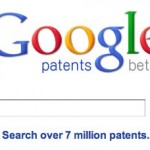As a former IP law firm shareholder and senior corporate lawyer, I know all too well the expense required to start and maintain an IP law practice. Not only are IP lawyers of all levels of experience paid handsomely, but so are the highly skilled paralegals, docket clerks and administrative professionals traditionally required create the infrastructure needed to handle the myriad of details involved in an IP law practice. Of course, this expensive infrastructure must be sustaining, so while a lawyer serves today’s clients, her eye must also be on finding the next client because payroll and rent obligations don’t take a holiday when clients do. This "feed the beast" nature of the IP law practice model was a primary reason that I decided several years ago that I would not again work in the traditional practice of law. How could I? The standard legal service framework required me to build
Why the IP Law Firm Business Model is Broken And What I Am Doing About It
Google Changes the Game Again–This Time for Patent Owners and Those Who Serve Them
 Patrick Anderson of the great Gametime IP blog reported the details of Google's new prior art searching tool*. This is such important news, I thought it important to repeat it in a separate post. Patrick provides detailed instructions for how to use the Google patent searching tool, and I will not repeat that information here. This post provides commentary on why I think this is a very good development for the patent world. Google's original announcement on its blog is here. It does not appear coincidental that Google is upgrading its patent searching capabilities: in this press release from June 2010 we are informed of the partnership between Google and the USPTO to increase the amount of US patent information available to the public.
When used correctly, Google's tool can help "democratize" the patent analysis process
Patrick Anderson of the great Gametime IP blog reported the details of Google's new prior art searching tool*. This is such important news, I thought it important to repeat it in a separate post. Patrick provides detailed instructions for how to use the Google patent searching tool, and I will not repeat that information here. This post provides commentary on why I think this is a very good development for the patent world. Google's original announcement on its blog is here. It does not appear coincidental that Google is upgrading its patent searching capabilities: in this press release from June 2010 we are informed of the partnership between Google and the USPTO to increase the amount of US patent information available to the public.
When used correctly, Google's tool can help "democratize" the patent analysis process
Want to Know More about IP Strategy? A Selection of Posts for In-House and Outside Counsel
This week, I am speaking at the Midwest IP Institute. I will be participating in a "fire side chat" with my good friend, Edna Vassilovski of Stoel, Rives LLP. Our session is entitled "How Patent Prosecutors and In-House Counsel Can Provide Work Product Better Aligned with Client's Business Needs." Specific topics we will discuss include:
- How clients’ views of IP and intangible assets are changing and ways both inside and outside counsel can stay relevant to clients today;
- What you can do to help clients obtain meaningful patents at reduced cost;
- How to really understand clients’ business goals and how to help make those happen; and
- How to help clients monetize their patents
IP Strategist on the Radio: 2 Recent Interviews
As my consulting practice becomes ever more busy, blogging must be relegated to times when client work is not pressing--that ever-elusive free time. But now that Summer is here, free time has been hard to come by--it's hard to write when at the pool with the kids or driving to Grandma's house--but I haven't been totally giving up my outreach. I recently participated in 2 radio interviews where I discussed the value of IP Strategy for entrepreneurs and inventors. Here I was on the 40 Year Old Business Virgin Radio Show with Dave Savage, Leader and President of The Inventors Association of Georgia and a person named Mohamed who has a really cool entrepreneurial story (sorry I didn't get his last name). The hosts of the show, Kile Lewis and Ted Jenkin, are irreverent business advisors, and you should enjoy the show. (I appear in the first half).
Much Ado About Patent Marking: Why It is So Hard for Corporations to Get It Right and Why False Marking Lawsuits Might be a Good Thing Overall
 It is fairly rare for patents to make hit the radar screen of mainstream news outlets but, recently, there has been much space allotted to the issue of patent mis-marking and lawsuits being brought by third parties for "violation" of the law requiring that products cannot be marked with an incorrect patent number. Indeed, the usually substance-free local paper in my mother's Southwest Florida community reported about the flood of patent mis-marking lawsuits. And, it is no wonder that the undoubtedly arcane issue of patent marking has reached the status of "news" in a small-town paper given the huge number of cases currently pending in the federal courts. It seems as if patent marking litigation may be the new business model for trial lawyers who are
It is fairly rare for patents to make hit the radar screen of mainstream news outlets but, recently, there has been much space allotted to the issue of patent mis-marking and lawsuits being brought by third parties for "violation" of the law requiring that products cannot be marked with an incorrect patent number. Indeed, the usually substance-free local paper in my mother's Southwest Florida community reported about the flood of patent mis-marking lawsuits. And, it is no wonder that the undoubtedly arcane issue of patent marking has reached the status of "news" in a small-town paper given the huge number of cases currently pending in the federal courts. It seems as if patent marking litigation may be the new business model for trial lawyers who are
Guest Poster David Boundy: A Detailed Examination of What the Proposed First to File Legislation Means to Business
(Editorial Note: Last week, I posted my thoughts on the proposed changes to the US patent laws from a first to invent to a first to file system. In response to my post, I received an exceedingly detailed and substantive comment from David Boundy, Vice President, Ass't Gen'l Counsel, Intellectual Property at Cantor, Fitzgerald. (David wanted me to say that this post his personal view, and does not reflect the views of Cantor, Fitzgerald.) David's viewpoint on what the proposed legislation will mean to business deserves a forum, and he has graciously allowed me to post his comment in total on the IP Asset Maximizer Blog. Anyone who works with business to generate patent assets should be concerned about the proposed changes.) About guest poster David Boundy: David Boundy has spent over a decade on Wall Street, first in several of New York's most prominent law
For Inventor of 21 Patents, Patent Troll Litigation Not Very Lucrative
Recently, I wrote a post on why I think that patent litigation is not a viable business model for inventors. Given a realistic deconstruction of the costs and possible damage awards, I concluded that, in most situations, it is not realistic for an inventor to presume that she will "hit the jackpot" by suing infringers and extracting settlement or damage awards. I obtained some pushback from this post, mostly from patent litigation lawyers, who contend that I am wrong in my view that patent litigation does not pay for inventors. Of course, everyone is entitled to their opinion, and I respect the views of others, however, no one who objects to my (somewhat) negative view of patent litigation as a business model, has provided me with numbers to discount my economic analysis of patent litigation. This recent post from The Prior Art blog entitled "Revealed! How Much Money a
A Patent Reality Check: Litigation Not a Viable Revenue Source for Most Inventors
The ability of an intrepid inventor to strike it rich from a great idea seems to be embedded in the DNA of many Americans. Perhaps this view emanates from the presence of patents in the US Constitution, which could create a feeling that US citizens have an "inalienable right" to use patent protection to their advantage. Alternatively, people may perceive the occasional media reports of successful inventors and substantial patent litigation awards as a signal that patents can serve as a path to wealth for those with great ideas (certainly, this is the Hollywood view). In truth, however, getting rich merely from a patent is a rare occurrence--maybe not as low a probability as winning the lottery, but the odds are incredibly long that any person can make money from a patented idea alone. Think about it: if all it took was a patent to make someone wealthy, there would be
How a Patent Strategy Focused Only on Obtaining the Lowest Cost Patents May Reveal a Company’s Future Inability to Remain Viable
Commentators like me frequently rail against what we view as the often unnecessarily high cost of obtaining patent protection. In truth, many patents are overpriced and provide questionable business value to their clients. Over-priced patents do not form the basis of this article, however. Instead, this is about the opposite phenomenon, i.e., under-priced patents. Specifically, in this article, I describe a company's desire to obtain low cost patents and what such a patent strategy may reveal about its long term viability. I was recently contacted by a large printer manufacturer ("PrinterCo" for the purposes of this discussion) to see whether I was interested in preparing patent applications for the price of $1300 each. This price seemed somewhat ridiculous to me because even the most "bargain basement" patent preparation prices that pop up on my Google sidebar advertising do not seem to dip beneath a threshold level of $2800. And, as a
Confessions of a Reluctant Convert to Electronic Patent File Management Systems & Why I Am Now a True Believer
For many years, vendors of office automation systems expended considerable effort trying to convince corporate and law firm patent attorneys to adopt paperless file management systems by touting the time and money savings associated with electronic files over the traditional patent file system. However, relatively few patent attorneys have done so, instead, remaining loyal to the traditional three-sided manila patent file folder. Until recently I was one of those patent attorneys. Now that I have discovered the vast efficiencies and improvements possible with these electronic systems, the question is why I remained true to this clearly outdated system of maintaining client patent prosecution records. Given the remarkable efficiency and knowledge management improvements possible with electronic patent file management systems, there can be no viable excuse for either corporate or law firm patent attorneys not to adopt such systems.In retrospect, I think I found that the heft and history represented by the


